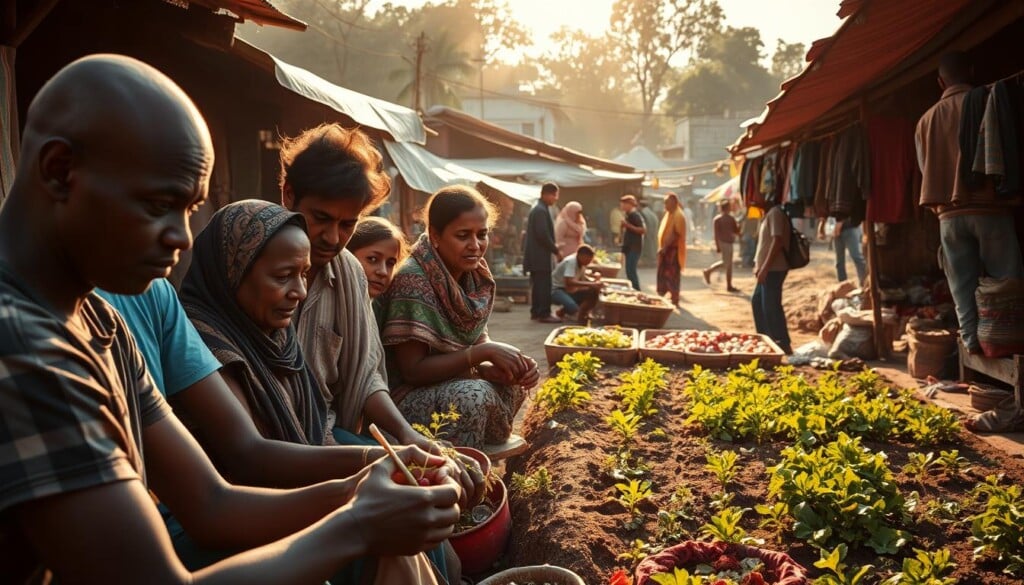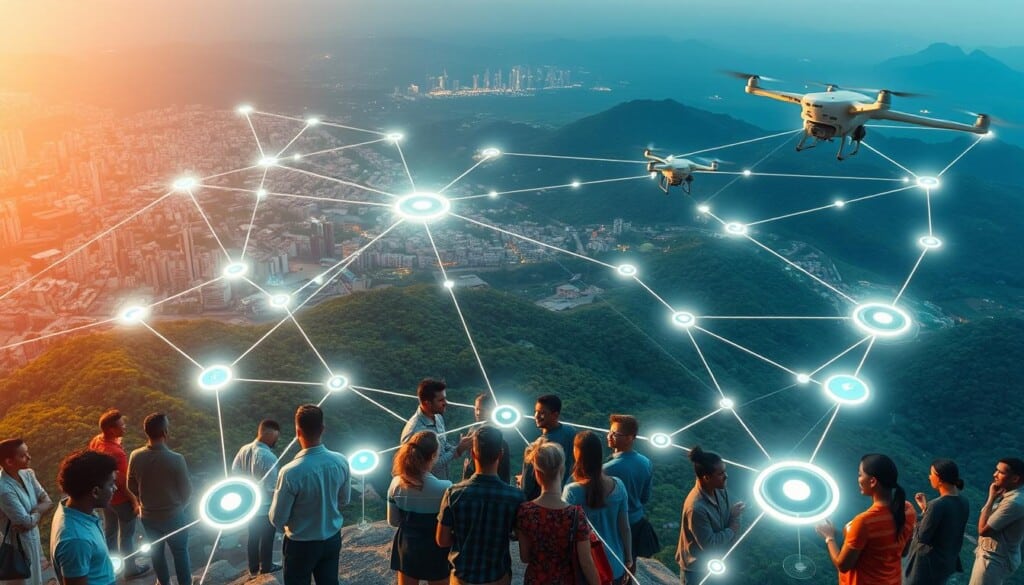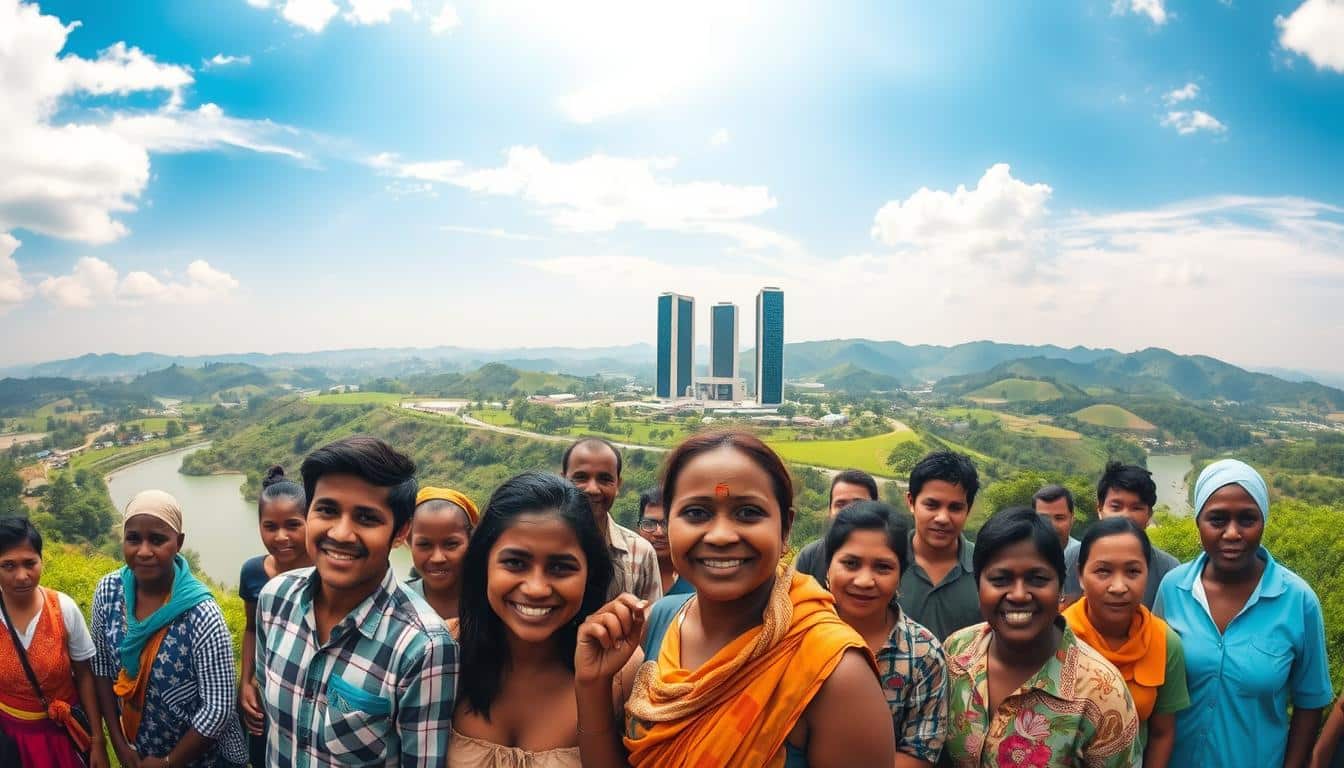What if the key to unlocking true progress in the world lies not just in the actions of large governments, but also in the hands of local businesses? This question invites exploration into the connection between international aid & development and local engagement. This guide will show how humanitarian assistance shapes communities and the role of poverty alleviation programs in sustainable development.
By looking at the work of organizations like LocalZ, we aim to highlight innovative ways to empower local populations. These efforts address pressing global challenges.
Key Takeaways
- International Aid & Development encompasses a wide range of initiatives aimed at global progress.
- Local businesses are key to making communities stronger against global challenges.
- Humanitarian assistance is vital for improving lives and reducing poverty.
- Sustainable development initiatives are essential for long-term success and community empowerment.
- Platforms like LocalZ help connect people, boosting community engagement and support.
Understanding International Aid
International aid is when richer countries help poorer ones. They send resources to improve life and help grow. It’s key for solving big problems, reducing poverty, and boosting growth.
Definition and Importance
International aid is vital for helping in emergencies and supporting long-term projects. It improves lives and helps communities recover. Humanitarian workers are essential in delivering this aid, tackling immediate needs and setting the stage for stability.
Types of International Aid
There are different types of international aid. Bilateral aid is direct support from one country to another. Multilateral aid comes from international groups. Humanitarian aid helps in emergencies, and development aid focuses on long-term growth.
Major Organizations Involved
Many big organizations help with international aid. The United Nations and the World Bank lead in coordinating and distributing aid. Non-governmental organizations (NGOs) also play a big role, making sure aid reaches those who need it most.
The Role of Local Businesses in Development
Local businesses are key to building strong communities and boosting the economy. They create jobs and help the local economy grow. This makes sure money stays in the community, building strong ties with residents.
Building Community Resilience
Local businesses offer vital services during tough times. They help communities face challenges like economic downturns or natural disasters. Their quick response shows their dedication to the community’s well-being.
Economic Contributions
Local businesses do more than just hire people. They also bring in tax money, helping fund local services and infrastructure. Keeping profits local supports sustainable growth and improves life quality. This stability encourages innovation and growth.
Collaborating with Global Initiatives
Working with global projects, local businesses share their local knowledge with the world. This leads to new solutions for both local and global challenges. Such partnerships help local businesses grow and make a bigger impact globally.

How LocalZ Enhances Community Engagement
LocalZ is a key player in local online directories, helping people and businesses connect. It creates a space for community interaction and supports local economies. Users can find many services and products nearby, building stronger local ties.
The Concept of Local Online Directories
LocalZ shows how local online directories work by bringing together important business info. It helps people find services they might not know about, making life better. This boosts community involvement and enriches daily life.
Streamlining Local Connections
LocalZ makes it easy to connect with local businesses. Users can find what they need quickly, based on where they are. This makes people feel more connected and strengthens community bonds.
Promoting Local Expertise
LocalZ values local knowledge for community growth. It encourages businesses to share their unique skills. This not only boosts their visibility but also helps the local economy grow.
Connecting Residents with Essential Services
LocalZ is a key tool for finding essential services in your area. It offers detailed listings to help you find local restaurants and skilled trades. This makes it easy to meet all your needs with ease and trust.
Finding Local Restaurants
Dining is a big part of community life. LocalZ lets users find a wide range of local restaurants. You can choose from casual spots to fancy places, all with clear information.
Accessing Skilled Trades
Home repairs need skilled tradespeople. LocalZ helps you find experts in plumbing and more. This service is reliable and builds trust in the community.
Other Local Services Offered
LocalZ also connects you with more services. You can find educational resources, healthcare, and fun activities. It makes it easier to live a well-rounded life, boosting community happiness.
The Financial Model Behind LocalZ
LocalZ has a solid financial plan that helps it connect with the community. A key part of this is the annual business listing fee. This fee helps keep the directory running and covers costs.
This fee is more than just a payment. It’s essential for keeping local businesses thriving in the ecosystem.
Annual Business Listing Fee Structure
The annual fee is set to be affordable for local businesses. It helps LocalZ grow and improve, making it a trusted resource for the community. Local businesses gain more visibility and reach, boosting their success in a tough market.
Community Affiliates and Their Impact
LocalZ values working with community affiliates, sharing 50% of the fees with them. This partnership strengthens the community and supports local businesses. It also helps with local projects and sustainable growth, making LocalZ more impactful.
The Impact of Locally-Focused Initiatives
Locally-focused initiatives make a big difference in communities. They tackle unique challenges and seize opportunities. These efforts are key to building stronger economies and a more resilient local scene.
By creating solutions that fit community needs, these initiatives help local development. They also get residents involved in meaningful ways.
Strengthening Local Economies
Locally-focused initiatives focus on a community’s strengths. They help small businesses grow, create jobs, and increase residents’ buying power. LocalZ is key in helping businesses succeed and communities thrive.
Supporting Community Organizations
Working with community organizations boosts the impact of initiatives. These groups tackle social issues and help spread local efforts further. They offer a chance to drive initiatives and build networks for vital services.
People can sign up as community affiliates to join these efforts.
Raising Awareness for Global Issues
Locally-focused initiatives also help raise awareness about global issues. They spark conversations about sustainability and social justice. This way, local actions contribute to solving global problems.

Leveraging Technology for Local Development
Digital platforms like LocalZ are key in changing local development. They use technology to make it easier for people to find information and services. This helps locals connect more with their community and its offerings.
How Digital Platforms Transform Communities
Digital platforms change how we interact locally. They make it easy to find what we need. This boosts community involvement and helps the local economy grow.
User-Friendly Search and Filter Options
Platforms like LocalZ make searching easy for users. They help people find what they need quickly. This makes using the platform a better experience.
Direct Booking Capabilities
Direct booking makes life easier for locals. It lets them book services quickly. This encourages more people to support local businesses.
Future of International Aid Through Local Networks
The world of international aid is changing, focusing more on local networks and grassroots efforts. These networks are key to effective community involvement and lasting development. Using platforms like LocalZ helps tackle big global problems with local actions.
Emerging Trends and Opportunities
Now, we see a move towards community-led models that value local knowledge. Technology helps these networks use resources better and reach more people. This leads to better teamwork between local businesses and global aid groups, making aid more sustainable.
Potential for Increased Community Involvement
Getting people involved in their communities is vital for international aid’s future. When locals join in, they help projects that really matter to them. This not only boosts local economies but also makes communities stronger and more ready for challenges.
When people support local projects, their efforts have a bigger impact. This creates a more connected and resourceful society.
Expanding the Scope of LocalZ
LocalZ is set to grow, helping communities connect more. It offers tools and resources that meet local needs, promoting teamwork. By adding more services and partnerships, LocalZ will link local efforts to global goals better.
This approach ensures that community ideas guide global strategies. It makes international aid a team effort.

Conclusion: A Call to Action
In today’s world, we all need to work together for sustainable development. We must support local businesses. This helps the local economy and lets businesses grow and help our communities.
Helping community-focused initiatives is also key. It builds strong relationships and helps growth. Every effort we make adds to the positive impact on our communities and the world.
Being part of the global movement means more than just watching. We need to get involved. We can do this by volunteering, supporting local businesses, or speaking out for change. Together, we can make a big difference and help our communities and the world.

